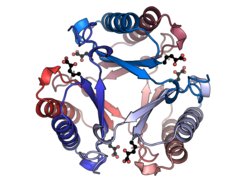Biology:4-Oxalocrotonate tautomerase
From HandWiki
| 4-oxalocrotonate tautomerase | |||||||||||
|---|---|---|---|---|---|---|---|---|---|---|---|
 Pseudomonas putida 4-oxalocrotonate tautomerase hexamer bound to 2-oxo-3-pentenoic acid. PDB: 1BJP | |||||||||||
| Identifiers | |||||||||||
| Symbol | Taut | ||||||||||
| Pfam | PF01361 | ||||||||||
| InterPro | IPR004370 | ||||||||||
| CDD | cd00491 | ||||||||||
| |||||||||||
4-Oxalocrotonate tautomerase (EC 5.3.2.6) or 4-OT is an enzyme that converts 2-hydroxymuconate to the αβ-unsaturated ketone, 2-oxo-3-hexenedioate.[1] This enzyme forms part of a bacterial metabolic pathway that oxidatively catabolizes toluene, o-xylene, 3-ethyltoluene, and 1,2,4-trimethylbenzene into intermediates of the citric acid cycle. With a monomer size of just 62 amino acid residues, the 4-Oxalocrotonate tautomerase is one of the smallest enzyme subunits known.[2] However, in solution, the enzyme forms a hexamer of six identical subunits, so the active site may be formed by amino acid residues from several subunits.[3] This enzyme is also unusual in that it uses a proline residue at the amino terminus as an active site residue.

Reaction catalyzed by 4-oxalocrotonate tautomerase.[1]
References
- ↑ 1.0 1.1 "4-Oxalocrotonate tautomerase, an enzyme composed of 62 amino acid residues per monomer". The Journal of Biological Chemistry 267 (25): 17716–21. September 1992. PMID 1339435.
- ↑ "The 4-oxalocrotonate tautomerase family of enzymes: how nature makes new enzymes using a beta-alpha-beta structural motif". Archives of Biochemistry and Biophysics 402 (1): 1–13. June 2002. doi:10.1016/S0003-9861(02)00052-8. PMID 12051677.
- ↑ "Enzymatic ketonization of 2-hydroxymuconate: specificity and mechanism investigated by the crystal structures of two isomerases". Biochemistry 35 (3): 792–802. January 1996. doi:10.1021/bi951732k. PMID 8547259.
 |

